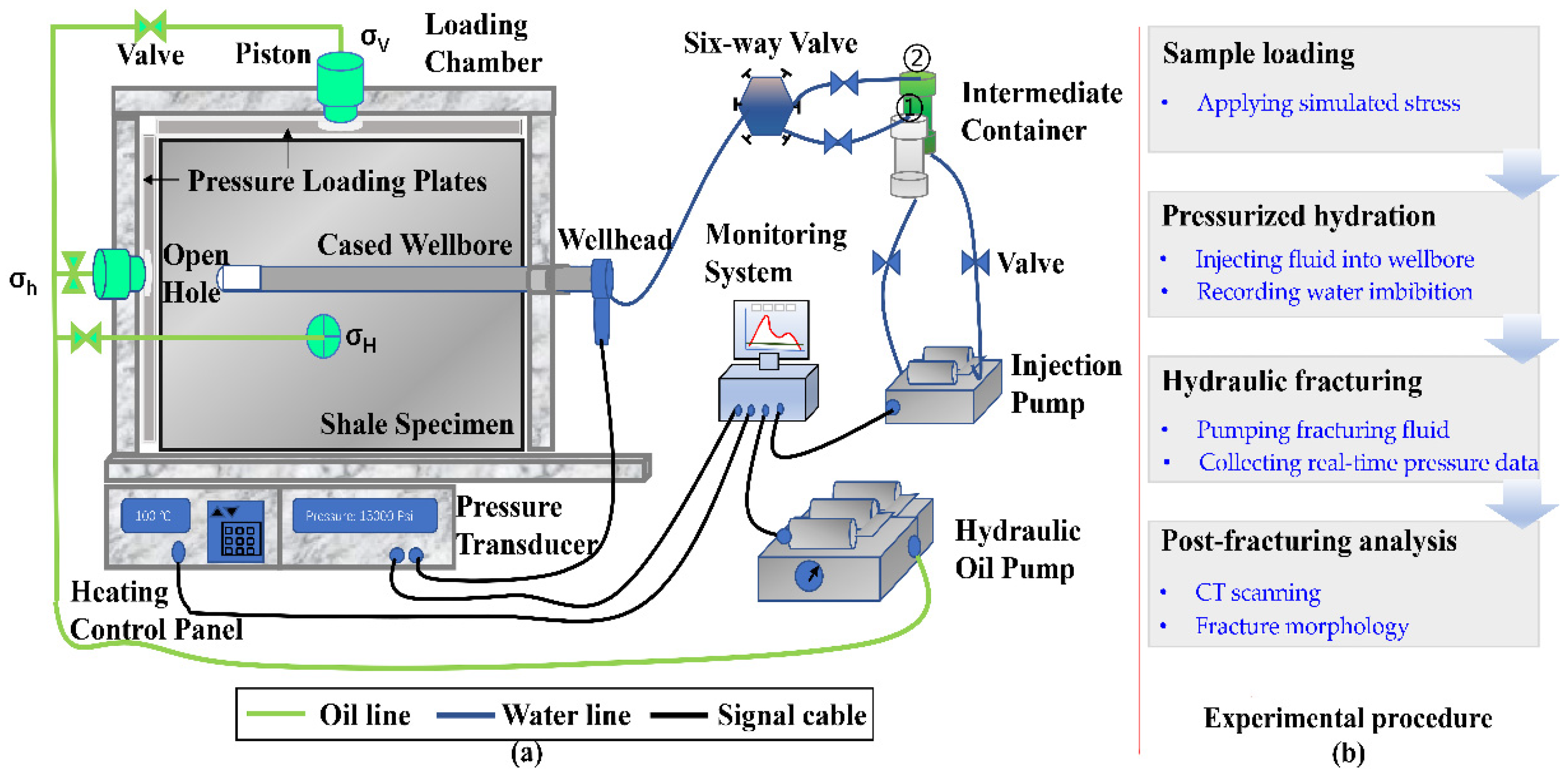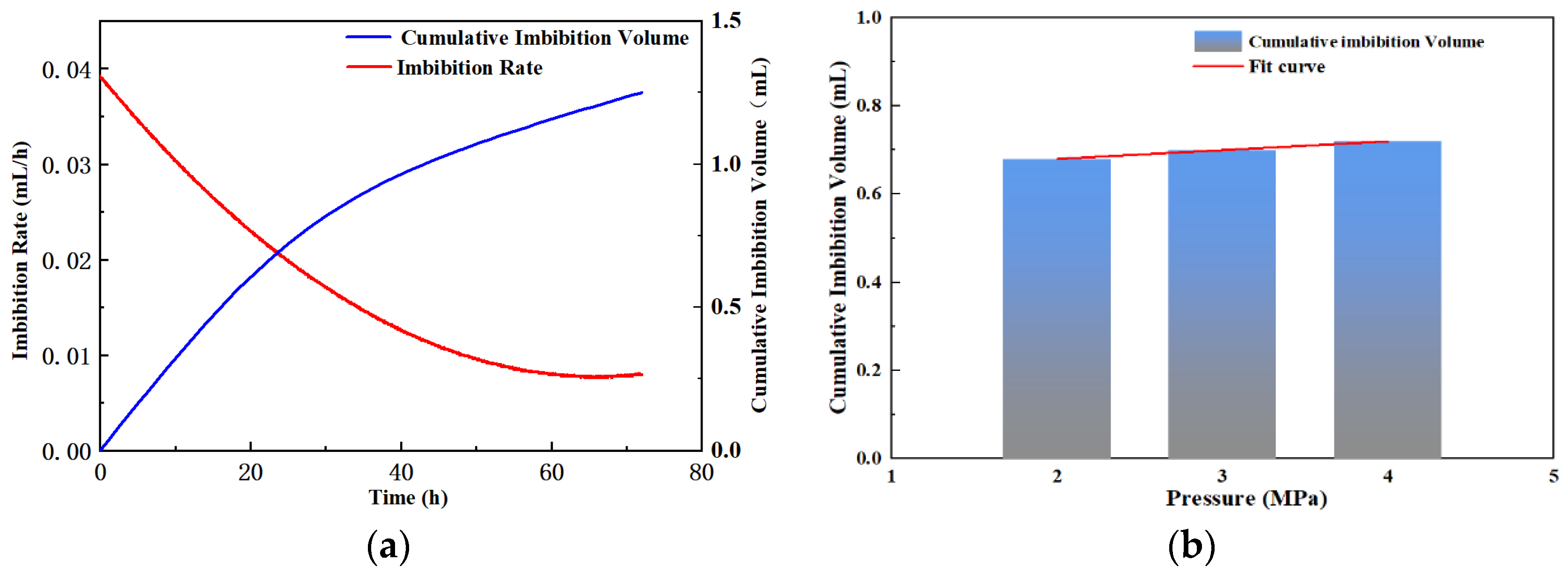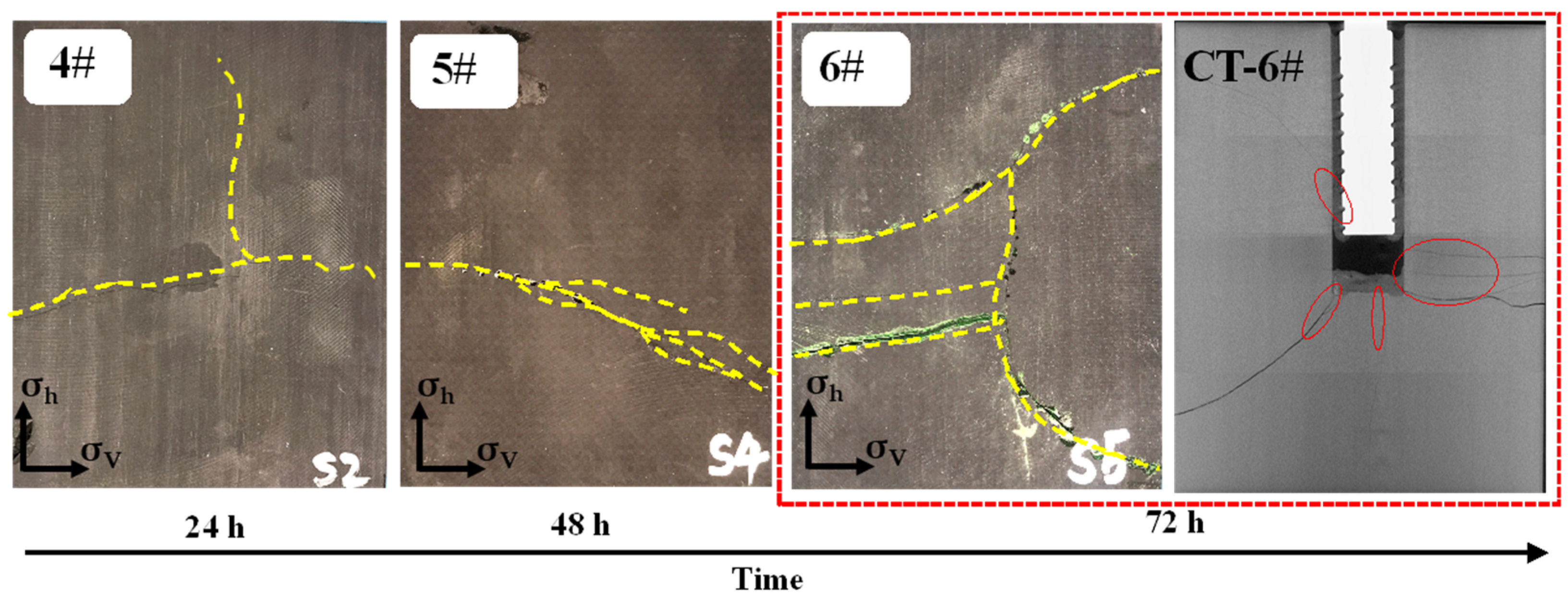Experimental Study on Hydraulic Fracture Initiation and Propagation in Hydrated Shale
Abstract
:1. Introduction
2. Experimental Setup and Methods
2.1. Mineral Composition and Mechanical Properties of Longmaxi Shale
2.2. Specimen Preparation and Experimental Scheme
2.3. Experimental Equipment and Procedures
3. Experimental Results and Analysis
3.1. Water Imbibition Volume
3.2. Fracture Morphologies and Pressure Curves
3.3. Effect of Shale Hydration on Fracture Morphology and Breakdown Pressure
3.3.1. Effect of the Hydration Pressure
3.3.2. Effect of the Hydration Time
4. Discussions
5. Conclusions
- Under confining pressure, the water imbibition volume increases with the hydration time, and the water imbibition rate reaches the peak within 24 h and then slows down.
- The breakdown pressure, the number of fractures, and the complexity of fractures are positively correlated with hydration time, and the increase in fracture complexity is mainly due to the increase in the number of fractures. The hydration pressure has little effect on the water imbibition during hydration. Under different hydration pressures, the breakdown pressure and the number of fractures are similar, and the complexity of fractures does not change significantly; all are T-shaped fractures.
- Microfracture closure during hydration is the main reason leading to the increase of breakdown pressure under the action of confining pressure. Higher breakdown pressure is beneficial to activate multiple microfractures in the open hole section, thus increasing the number and complexity of fractures.
- In the future, it is necessary to use scanning electron microscopy and other microscopic means to analyze the hydration mechanism in depth, including hydration stress and strain, and to quantitatively analyze the activation of microfractures under hydration, in order to make the experimental results more universal.
Author Contributions
Funding
Data Availability Statement
Conflicts of Interest
Nomenclature
| σh | Minimum horizontal principal stress, MPa |
| σH | Maximum horizontal principal stress, MPa |
| σV | Vertical stress, MPa |
| Q | Pumping rate, mL/min |
| Pb | Breakdown pressure, MPa |
| μ | Viscosity of the fracturing fluid, mPa⸱s |
| E | Young’s modulus, GPa |
| KIC | Fracture toughness of rock, MPa⸱m1/2 |
| ν | Poisson’s ratio, dimensionless |
| t | Time, s |
| CNC | Computer numerical control |
References
- Dong, D.; Zou, C.; Yang, H.; Wang, Y.; Li, X.; Chen, G.; Wang, S.; Lü, Z.; Huang, Y. Progress and prospects of shale gas exploration and development in China. Acta Pet. Sin. 2012, 33 (Suppl. S1), 107–114, 9. [Google Scholar]
- Zhang, S.; Sheng, J.J.; Qiu, Z. Water adsorption on kaolinite and illite after polyamine adsorption. J. Pet. Sci. Eng. 2016, 142, 13–20. [Google Scholar] [CrossRef]
- Zhang, X.B.; Li, L.; Xu, X.K.; Yang, Y.Y.; Fang, Y.S.; Xiao, Q.; Yang, J. Study on macro-microscopic characteristics of longmaxi shale hydration process. Drill. Prod. Technol. 2022, 44, 115–118, 136. [Google Scholar]
- Liu, X.; Xiong, J.; Liang, L. Hydration experiment of hard brittle shale of the longmaxi formation. J. Southwest Pet. Univ. (Sci. Technol. Ed.) 2016, 38, 178–186. [Google Scholar]
- Ding, M.; Kantzas, A.; Lastockin, D. Evaluation of gas saturation during water imbibition experiments. J. Can. Pet. Technol. 2006, 45, 29–35. [Google Scholar] [CrossRef]
- Dehghanpour, H.; Lan, Q.; Saeed, Y.; Fei, H.; Qi, Z. Spontaneous imbibition of brine and oil in gas shales: Effect of water adsorption and resulting microfractures. Energy Fuels 2013, 27, 3039–3049. [Google Scholar] [CrossRef]
- Holditch, S.A. Factors affecting water blocking and gas flow from hydraulically fractured gas wells. J. Pet. Technol. 1979, 31, 1515–1524. [Google Scholar] [CrossRef]
- Li, K.; Horne, R.N. An analytical scaling method for spontaneous imbibition in gas/water/rock systems. SPE J. 2004, 9, 322–329. [Google Scholar] [CrossRef]
- Peng, S.; Shevchenko, P.; Periwal, P.; Reed, R.M. Water-oil displacement in shale: New insights from a comparative study integrating imbibition tests and multiscale imaging. SPE J. 2021, 26, 3285–3299. [Google Scholar] [CrossRef]
- Handy, L.L. Determination of effective capillary pressures for porous media from imbibition data. Trans. AIME 1960, 219, 75–80. [Google Scholar] [CrossRef]
- Gupta, A.; Xu, M.; Dehghanpour, H.; Bearinger, D. Experimental investigation for microscale stimulation of shales by water imbibition during the shut-in periods. In Proceedings of the SPE Unconventional Resources Conference, Calgary, AB, Canada, 15–16 February 2017. SPE-185058-MS. [Google Scholar]
- Suarez, M.; Rivera, R. Water imbibition in oilfield rocks and applications to oil recovery. J. Propuls. Power 2009, 6, 535–543. [Google Scholar]
- Arab, D.; Bryant, S.L.; Torsæter, O.; Kantzas, A. Water flooding of sandstone oil reservoirs: Underlying mechanisms in imbibition vs. drainage displacement. J. Pet. Sci. Eng. 2022, 213, 110379. [Google Scholar] [CrossRef]
- Zhang, S.; Qiu, Z.; Huang, W. Water-adsorption properties of Xiazijie montmorillonite intercalated with polyamine. Clay Miner. 2015, 50, 537–548. [Google Scholar] [CrossRef]
- Peng, S.; LaManna, J.; Periwal, P.; Shevchenko, P. Water imbibition and oil recovery in shale: Dynamics and mechanisms using integrated centimeter-to-nanometer-scale imaging. SPE Reserv. Eval. Eng. 2022, 1–13. [Google Scholar] [CrossRef]
- Al-Arfaj, M.; Al-Osail, M.; Sultan, A. Monitoring imbibition of water into shale pore system: State of the art. In Proceedings of the SPE/IATMI Asia Pacific Oil & Gas Conference & Exhibition, Jakarta, Indonesia, 17–19 October 2017. [Google Scholar]
- Liang, D.C. Review on the study of shale hydration mechanism. Drill. Fluid Complet. Fluid 1997, 14, 29–31. [Google Scholar]
- Yu, Z.L.; Guo, G.F.; Yu, H.; Li, Q.; Zhang, Y.L. Damage of hydration effect to micropore structure of shale. J. Xi’an Shiyou Univ. (Nat. Sci. Ed.) 2022, 37, 44–50. [Google Scholar]
- Lu, Y.H.; Chen, M.; Jin, Y.; Teng, Q.X.; Wu, W.; Liu, X.Q. Experimental study of strength properties of deep mudstone under drilling fluid soaking. Chin. J. Rock Mech. Eng. 2012, 31, 1399–1405. [Google Scholar]
- Gray, R. Water-sensitive damage mechanism and injection water source optimization of low permeability sandy conglomerate reservoirs. Pet. Explor. Dev. 2019, 46, 1–11. [Google Scholar]
- Michael, W.C.; Ron, E.H.; Russell, G. Minimising clay sensitivity to fresh water following brine influx. In Proceedings of the SPE International Symposium on Formation Damage Control, Lafayette, LA, USA, 15–17 February 2000. SPE-58748-MS. [Google Scholar]
- Zhang, S.; Sheng, J.J. Effect of water imbibition on hydration induced fracture and permeability of shale cores. J. Nat. Gas Sci. Eng. 2017, 45, 726–737. [Google Scholar] [CrossRef]
- Ma, T.S.; Chen, P. Study of meso-damage characteristics of shale hydration based on CT scanning technology. Pet. Explor. Dev. 2014, 41, 227–233. [Google Scholar] [CrossRef]
- Hou, Z.K. Research on Hydraulic Fracturing Tests and Mechanism of Crack Extension of Longmaxi Shale; Chongqing University: Chongqing, China, 2018. [Google Scholar]
- Li, N.; Zou, Y.; Zhang, S.; Ma, X.; Zhu, X.; Li, S.; Cao, T. Rock brittleness evaluation based on energy dissipation under triaxial compression. J. Pet. Sci. Eng. 2019, 183, 106349. [Google Scholar] [CrossRef]







| Specimen No. | Confining Pressure | Young’s Modulus (GPa) | Poisson’s Ratio | Compressive Strength (MPa) | Tensile Strength (MPa) | Brittleness Index (Decimals) |
|---|---|---|---|---|---|---|
| V1(V-1) | 0 | 25.74 | 0.24 | 60.5 | 6.1 | 0.48 |
| V2(V-2) | 20 | 22.75 | 0.22 | 112.1 | 7.6 | 0.45 |
| V3(V-3) | 40 | 30.73 | 0.25 | 131.9 | 5.6 | 0.44 |
| V4(V-4) | 60 | 24.14 | 0.20 | 237.8 | 5.1 | 0.38 |
| Specimen No. | Stress (MPa) σh-σH-σv | Flowrate (mL·min−1) | Viscosity (mPa·s) | Imbibition Time (h) | Imbibition Pressure (MPa) |
|---|---|---|---|---|---|
| 1# | 3-18-25 | 5 | 100 | 0 | 0 |
| 2# | 24 | 2 | |||
| 3# | 24 | 4 | |||
| 4# | 24 | 3 | |||
| 5# | 48 | 3 | |||
| 6# | 72 | 3 |
| Specimen No. | Number of Fractures | Hydration Pressure and Time | Breakdown Pressure (MPa) | Overall Fracture Morphology |
|---|---|---|---|---|
| 1# | 1 | 0 MPa, 0 h | 24.8 | A transverse fracture along the direction of σH |
| 2# | 2 | 2 MPa, 24 h | 28.7 | A transverse fracture along the direction of σH, which activated a bedding plane locally to form a T-shaped fracture |
| 3# | 2 | 4 MPa, 24 h | 30.0 | A transverse fracture arrested by a bedding plane, forming a T-shaped fracture |
| 4# | 2 | 3 MPa, 24 h | 27.9 | A transverse fracture along the direction of σH, which activated a bedding plane locally to form a T-shaped fracture |
| 5# | 3 | 3 MPa, 48 h | 40.2 | Three transverse fractures merging into one during propagation |
| 6# | 6 | 4 MPa, 72 h | 46.4 | Three transverse fractures and one bedding plane resulting in a fracture network |
Publisher’s Note: MDPI stays neutral with regard to jurisdictional claims in published maps and institutional affiliations. |
© 2022 by the authors. Licensee MDPI, Basel, Switzerland. This article is an open access article distributed under the terms and conditions of the Creative Commons Attribution (CC BY) license (https://creativecommons.org/licenses/by/4.0/).
Share and Cite
Duan, G.; Mou, J.; Zou, Y.; Gao, B.; Yang, L.; He, Y. Experimental Study on Hydraulic Fracture Initiation and Propagation in Hydrated Shale. Energies 2022, 15, 7110. https://doi.org/10.3390/en15197110
Duan G, Mou J, Zou Y, Gao B, Yang L, He Y. Experimental Study on Hydraulic Fracture Initiation and Propagation in Hydrated Shale. Energies. 2022; 15(19):7110. https://doi.org/10.3390/en15197110
Chicago/Turabian StyleDuan, Guifu, Jianye Mou, Yushi Zou, Budong Gao, Lin Yang, and Yufei He. 2022. "Experimental Study on Hydraulic Fracture Initiation and Propagation in Hydrated Shale" Energies 15, no. 19: 7110. https://doi.org/10.3390/en15197110





